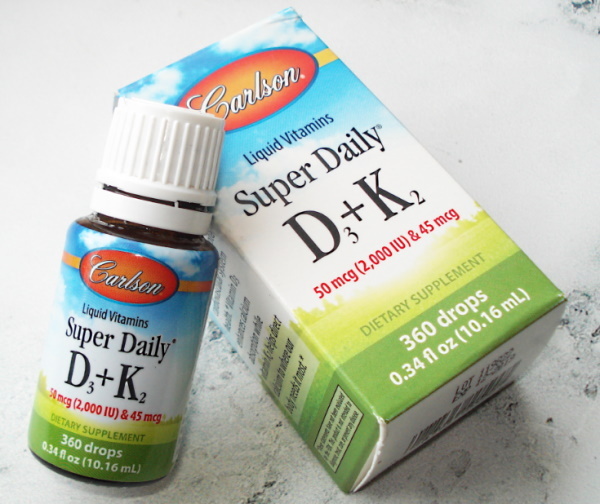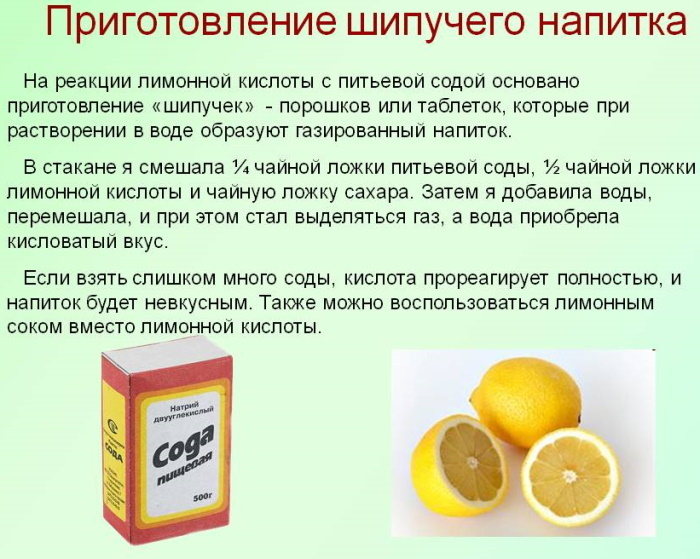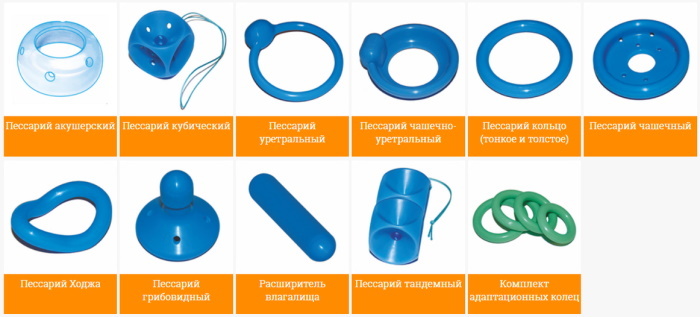Fiber is a related concept, but narrower than "dietary fiber". Fiber (or cellulose) is a complex polymeric carbohydrate that is found in the list of foods of plant origin.
Record content:
- 1 What is fiber?
- 2 Types of fiber
- 3 Why is fiber deficiency dangerous?
- 4 The benefits of fiber
- 5 Slimming benefits
- 6 What fiber is best for constipation
- 7 How to take fiber
- 8 Fiber-rich foods
- 9 Are additional fiber sources needed
- 10 Fiber videos
What is fiber?
Pure cellulose is a white solid, insoluble in plain water. In nature, fiber can be found in the cell walls of higher plants. Formed by attaching glucose molecules.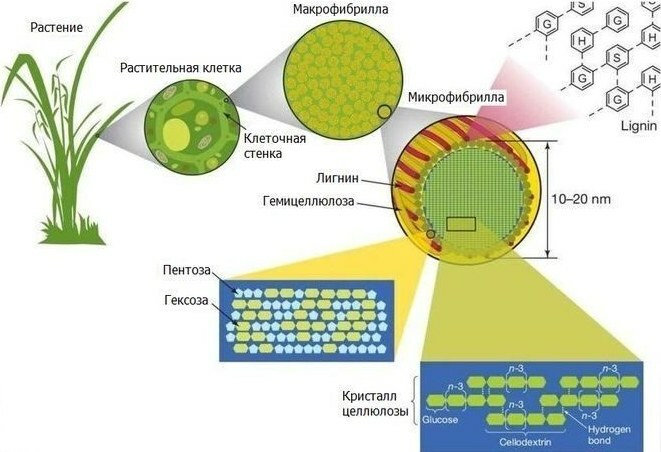
Dietary fiber is a broader concept that includes fiber. Dietary fiber refers to those components of the human diet that are not digested in the gastrointestinal tract. Despite this, dietary fiber has many important functions.
Fibers are classified into lignin and non-starch polysaccharides, of which cellulose is a subtype. All of them are ballast substances - that is, substances that are not digested by gastric and intestinal enzymes.
Fiber intake is an essential part of making the transition to a healthy diet. The fact is that undigested cellulose, entering the intestines, is processed by local friendly microorganisms.
Types of fiber
The simplest classification of types of fiber is divided into:
- soluble;
- insoluble.

Moreover, both the first and second, fibers can improve a person's well-being. They differ in the type of action. The deficiency of one type can be made up for with others.
Soluble fiber is able to absorb liquid. It grows in size, turns into a kind of cream or gel in the stomach. It is plant fiber that is called prebiotics.
Prebiotics are vital food for bacteria living in the intestines. The intestinal microbiota produces a number of vital vitamins and substances, attacks pathogenic microflora and viruses, and produces enzymes. The main function of microorganisms is to maintain immunity.
Insoluble fiber does not change its consistency after entering the stomach. It is unable to absorb moisture and grow in size. This type of fiber accelerates the passage of the food bolus through the digestive tract.
If insoluble dietary fiber supports the functions of the gastrointestinal tract (stimulates peristalsis, promotes the production of enzymes), then soluble stimulates the digestion process and slightly accelerates metabolism.
The medical classification is more detailed.
Experts divide fiber not only by the degree of solubility, but also by fermentation:
| Group | Types, name and use | Sources of |
| Fermentable | These are pectins, resistant starch, fructans, beta-glucans, gums, plant mucus and chitosan. Essential for the gut microbiome. | Pulses. Only 200 grams of ripe peas or beans can replenish your daily intake of fermentable fiber. |
| Partially fermentable | Actually, cellulose. Used in pharmaceuticals. It is taken as a food supplement, contained in products. | Edible and inedible plants. For example, cotton seeds contain 90% cellulose. Whole grains contain 10-20% of this fiber. |
| Nonfermentable | These include hemicellulose, lingins, chitin. | Like cellulose, hemicellulose is found in plants. Lingins are found in the cells of vascular higher plants and algae. Chitin is a fiber that can be obtained from mushrooms. |
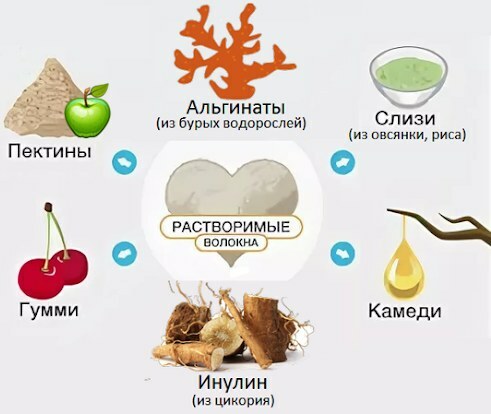

Fermentation in this context refers to the degree to which fiber is processed by intestinal microorganisms. The fibers in the food bolus pass to the lower intestines in the same state, but are processed by bacteria in the rectum.
Another type of plant dietary fiber is tunicin. Uncommon and well-known, but no less useful. The peculiarity of tunicin is that it is obtained from the mantle (skin) of underwater inhabitants. Most of all the tunicin is found in the tunic of the ascidians living at the bottom of the ocean.
Glucomannan is a relatively recent discovery by Norwegian scientists. Another little-known type of fiber that research has shown significantly contributes to weight loss. Dietary supplements serve as a source of glucomannan in the diet.
Resistant starch saturates best. It is found in green bananas, beans, and oats. American scientists were engaged in in-depth research of resistant starch. They concluded that this type of fermented fiber reduces the amount of food eaten at a time.
Why is fiber deficiency dangerous?
Lack of fiber in the diet is dangerous due to difficulties in the process of digestion and defecation. First of all, intestinal peristalsis is disturbed, constipation occurs.
Lack of dietary fiber increases the risk of metabolic disorders in the body. For example, a lack of normal fiber increases blood glucose levels. In turn, high sugar provokes bouts of overeating due to the constant feeling of hunger.
Endocrine mechanisms associated with the hormones insulin, cortisol, ghrelin and leptin are disrupted. These hormones are important for the regulation of body weight, the secretion of female hormones, and so on.
Dietary fiber reduces the level of "bad" cholesterol. In turn, inadequate fiber intake increases the risk of developing chronically high cholesterol levels and, as a result, the occurrence of cardiovascular disease.
Fiber, a list of foods with a high content of which every person needs, regulates the water-salt balance. A lack of fiber can cause swelling.
Due to insufficient fiber intake, problems with the act of defecation arise. Chronic constipation provokes the appearance of anal fissures and polyps. An equally serious consequence is the intoxication of the whole organism.
Signs of inadequate fiber intake include:
- Constant hunger. Even after eating.
- Chronically high sugar levels.
- High blood pressure.
- Intoxication of the body: nausea, abdominal pain, vomiting.
- Problems during weight loss, plateau, breakdowns.
Fiber-rich foods are high in vitamins. Therefore, together with the symptoms of a lack of fiber, vitamin deficiency can develop. When neglected, it develops into a series of severe pathologies and symptoms.
The benefits of fiber
Both types of dietary fiber create a favorable environment for the development of friendly microflora. Eating enough fiber suppresses pathogenic viruses and bacteria.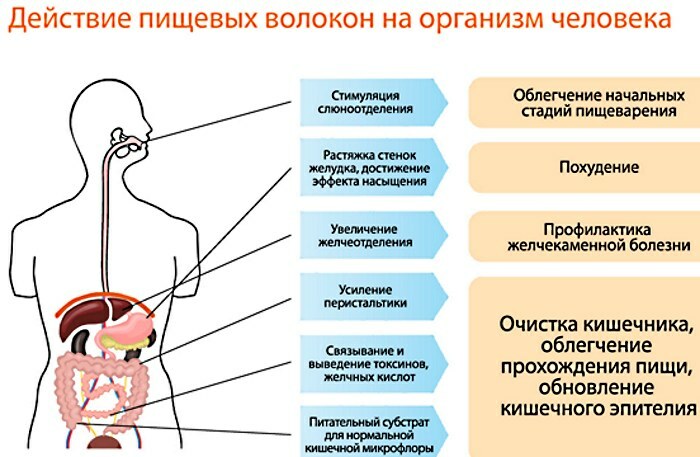
Fiber is a substance with a low glycemic index. This means that dietary fiber is recommended for people with diabetes. If you add foods containing fiber to meals, you can reduce their insulin load.
In addition, fiber can lower blood sugar. Dietary fiber is included in the diet of people with diabetes. They interfere with the absorption of fast carbohydrates and increase insulin sensitivity. Carbohydrate metabolism is normalized. The risk of developing type 2 diabetes is reduced.
Dietary fiber helps to normalize blood cholesterol levels. High "bad" cholesterol increases the risk of developing cardiovascular diseases and impairs blood circulation. Soluble fiber interferes with the absorption of saturated fatty acids.
The complex preventive effect of dietary fiber, namely, lowering cholesterol and glucose levels, reducing body weight, also reduces the risk of developing cardiovascular diseases: stroke, heart attack, coronary artery disease hearts.
The diuretic and laxative effect of fiber promotes gentle and timely bowel movement. Insoluble fiber stimulates smooth muscle contractions in the walls of the digestive tube and accelerates the passage of chyme.
Canadian scientists have proven that plant fiber improves the functioning of the immune system. Bacteria are the reason for this again. The friendly intestinal microflora produces B vitamins and essential fatty acids.
Bacteria stimulate the production of neurotransmitters - substances needed to transmit impulses in the brain. Lack of neurotransmitters such as serotonin, dopamine or norepinephrine can lead to stress, irritation, and aggression.
Microorganisms recycle toxins that accumulate in the intestines and naturally detoxify them. The majority of people suffering from intoxication have a disturbed intestinal microflora.
Fiber, the list of foods with which is presented below, will help restore regular bowel movements and the proper functioning of individual organs. For example, without the work of friendly bacteria, a number of vitamins and substances necessary for life are practically not produced: potassium, zinc, tannins.
Slimming benefits
Fiber is a product that reduces calorie content, glycemic index and fat content in various dishes. By adding bran or refined fiber, for example, to biscuit or muffin dough, you can significantly reduce its calorie content and insulin load.
Once in the stomach, soluble fiber swells, increases in size and fills it. Despite the fact that fiber is not digested in the gastrointestinal tract, it still makes you feel full. Dietary fibers expand the walls of the stomach, and this mechanical effect removes the feeling of hunger.
Dietary fiber helps lower blood sugar levels. High glucose levels after consuming sugary foods and confectionery produce an equally dramatic drop. When the sugar level drops sharply, impulses enter the hunger center that induce active eating behavior.
Relatively constant glucose levels help regulate eating behavior: it turns from paroxysmal to smooth, accompanied by a constant feeling of mild satiety.
Foods that contain fiber are generally healthy and low in calories. On the contrary, refined foods are quickly digested and are practically devoid of vitamins. The inclusion in the diet of foods containing dietary fiber contributes to the regulation of eating behavior, stimulates fat burning.
What fiber is best for constipation
It is worth starting with the fact that constipation is a disease in which the last act of defecation was recorded for at least 3 days before going to the doctor. This condition is already considered a pathology and should be treated in conjunction with a gastroenterologist.
Situational symptoms of constipation are treated on their own. They are not so scary and can arise on the basis of stress, a sharp change in diet, constraint, environmental conditions, time zone and composition of water consumed.
Fiber, the list of foods that can help relieve constipation, differs in the way it works. When choosing fiber for the treatment of constipation, you should adhere to the recommendations of the attending physician and your own preferences, observations about well-being.
The main difference between soluble and insoluble fiber is the gentle action and hydration of the gastrointestinal tract. Insoluble, on the contrary, acts roughly. It cleans the walls of the stomach, intestines and serves as food for microorganisms living mainly in the colon.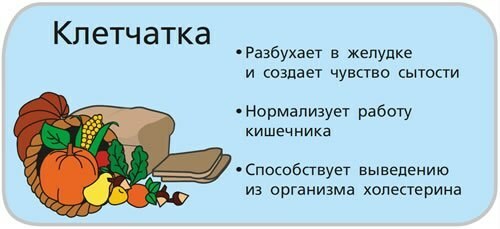
People with gastroenterological diagnoses such as anal fissures, hemorrhoids, ulcers, pancreatitis should pay attention to soluble fiber. It will gently cleanse the intestines without exacerbating the symptoms of diseases.
In case of microflora deficiency, suppression of immunity, it is best to take insoluble coarse fiber. If there are no problems with the passage of the food bolus through the gastrointestinal tract, then insoluble fiber will not harm.
How to take fiber
In order to lose weight with fiber, you need to eat a balanced diet and combine dietary fiber intake. You won't be able to eat bran fast food and lose weight. In any case, there must be a calorie deficit.
Thus, to lose weight you need:
- Calculate daily calorie intake.
- Make a diet with a calorie deficit - about 20-30% less than the general norm.
- Eat a balanced diet: the diet should contain fats, proteins, and carbohydrates.
- Fiber is best taken 30-50 minutes before meals.
- Be sure to drink plenty of water: 1-2 glasses.
- Add physical activity: walking, running, fitness.
To improve digestion, it is sufficient to include foods containing dietary fiber. It is important to correctly combine products so that there is no constipation or, conversely, diarrhea. For example, highly fatty foods do not go well with sugary foods.
In order to improve digestion, you need to adhere to the following recommendations:
- It is best to introduce fiber into the diet gradually, starting with small portions of fruits and vegetables.
- The starting dose of dietary fiber is 10 g. Each day, their content should be increased by 2-5 g.
- Consume a sufficient amount of liquid: 1.5-3 liters per day.
- Take 1-2 tbsp daily. l. bran or fiber. Can be diluted in water or kefir.
- Combine vegetables with lean meats and fish.
- Fruit is recommended to be consumed separately. After or before the main meal.
Insoluble fiber is suitable for cleansing the intestines. It is sold in pharmacies and supermarkets with the corresponding name. Insoluble fiber does not swell in the stomach, but cleans its walls and stimulates peristalsis.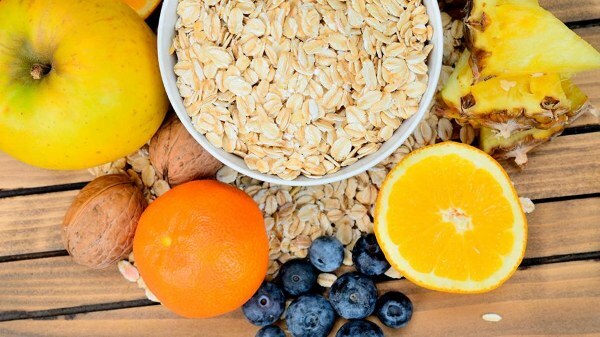
Bowel cleansing is a complex process that involves a course of treatment in compliance with the following recommendations:
- The course should be continued for at least 2 weeks.
- Consume a sufficient amount of clean water, combine fiber with fermented milk products.
- Additional small physical activity will only benefit, accelerate the peristalsis of the stomach and intestines.
- It is not recommended to take fiber during medication treatment. She will not allow the medicine to be fully absorbed. The drugs are absorbed only 1-2 hours after taking dietary fiber.
In addition, you must comply with the rate of fiber intake. It is calculated depending on the age and gender of a person using formulas. Taking into account pregnancy or lactation, menopause.
However, there are minimum values for dietary fiber. They do not depend on gender - only on age. This is the required amount to maintain the body.
Minimum values for people of different ages:
| Age | Rate (g) |
| 1-3 years | 10 |
| 4-8 years old | 17-20 |
| 9-13 years old | 22-25 |
| 14-18 years old | 25-30 |
| 19-40 years old | 32-38 |
| 41-50 years old | 30-35 |
| 51 and more | 20-26 |
Fiber-rich foods
The table below shows the foods with the most fiber. Regular consumption of these products stimulates intestinal motility, improves digestion and normalizes metabolic processes.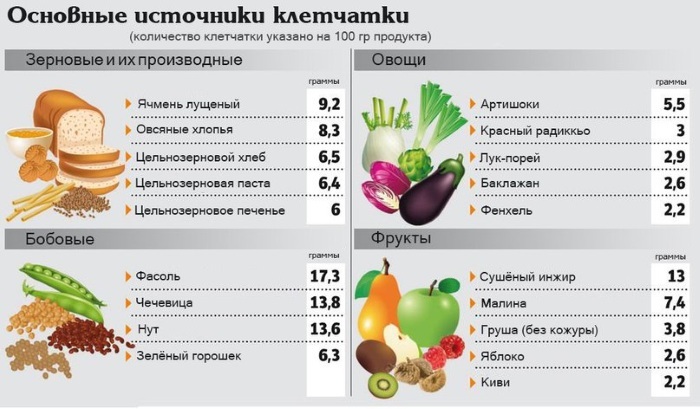
Fiber (product list):
| Product | Calorie content, BZHU (100 g) | Fiber (100 g) | Beneficial features |
| Bran (rye and wheat) | 165 kcal; B - 16, F - 4, U - 17. | 44 | Record holder for fiber content. The bran is rich in B vitamins, contains 50% of the norm of potassium, 575% of manganese, 100% of copper and phosphorus. |
| Chia seeds | 486 kcal; B - 16, F - 30, U - 8. | 34.4 | Contains essential fatty acids including Omega-3. The seeds are rich in calcium - 63% DV, 108% phosphorus, 100% selenium. |
| Flax seeds | 534 kcal; B - 18, F - 42, U - 2. | 27.3 | Known for effects that improve digestion. Flax seeds secrete mucus, which stimulates gastrointestinal motility and facilitates gentle gastric emptying. Source of Omega-3 fatty acids and a number of vitamins. Suppresses the feeling of hunger. |
| Grain beans | 298 kcal; B - 21, F - 2, U - 47. | 12 | A source of quality plant proteins, B vitamins, cobalt, manganese and selenium. Saturates well. |
| Walnut | 656 kcal; B - 16, F - 60, U - 11. | 6 | The unsaturated fats contained in nuts help to improve brain activity, regulate the passage of impulses along the axons of neurons. |
| Mushroom | 22 kcal; B - 2, F - 1, U - 0. | 5 | Despite the relatively low fiber content, honey mushrooms are a low-calorie product. It contains B vitamins, PP, potassium and beta-carotene. |
| Dried kelp | 207 kcal; B - 7, F - 2, U - 25. | 5 | A valuable source of iodine. Has a high nutritional rating. Contains in large quantities almost all trace elements and vitamins necessary for the body. Does not contain vitamins D, A. |
| Cranberry | 28 kcal; B - 0, F - 0, U - 4. | 3.3 | Contains 200% of the daily value of vitamin H. |
| White cabbage | 28 kcal; B - 2, F - 0, U - 5. | 2 | Low-calorie product. It won't be so difficult to get enough fiber. Contains 177% silicon, 63% vitamins C, K. |
| Pumpkin | 22 kcal; B - 1, F - 0, U - 4. | 2 | Contains 30% of the daily value of beta-carotene, 100% of the value of silicon and 28% of vitamin A, a small amount of B vitamins. |
| Broccoli | 34 kcal; B - 3, F - 0, U - 4. | 3 | Source of selenium - 260% of the daily value and vitamin C - 99%, vitamin K - 85%. Contains potassium and B vitamins. |
| Carrot | 35 kcal; B - 1, F - 0, U - 7. | 3 | Known for its high levels of beta-carotene and vitamin A, which support vision and stimulate the nervous system. |
Are additional fiber sources needed
Fiber has the recommended daily intake of 30 g for women and 38 g for middle-aged men (30-40 years). According to a number of modern studies, people do not consume even 50% of the dietary fiber from food.
Nutritionists and gastroenterologists believe that it is best to consume fiber from whole foods. For example, a 300g cup of freshly chopped cabbage can get 20% of your daily fiber and only 4% of calories.
The point is that whole foods are high in vitamins and minerals. Pure fiber sold in pharmacies and supermarkets is a concentrate of indigestible fiber. It will help regulate the amount of fiber in the diet, but it will not help with vitamin deficiency or dysfunction of certain organs.
Fiber is good for the body, but after a series of studies confirming its effectiveness, dietary fiber has almost become a panacea for all diseases. Many manufacturers use fiber markers to market their products.
In fact, high amounts of dietary fiber can be as harmful as normal amounts can be beneficial. Often, confectionery and bakery products contain not only fiber, but also a number of harmful substances: trans fats, sugars and syrups, regulators and stimulants.
For "pure" fiber to benefit the body, you need to monitor the vitaminization of the body. By adding only fiber to their diet, a person eliminates the list of nutrients from whole foods that support the proper functioning of the body.
Author: Svitkevich Yulia Vyacheslavovna
Fiber videos
Fiber-containing foods:

